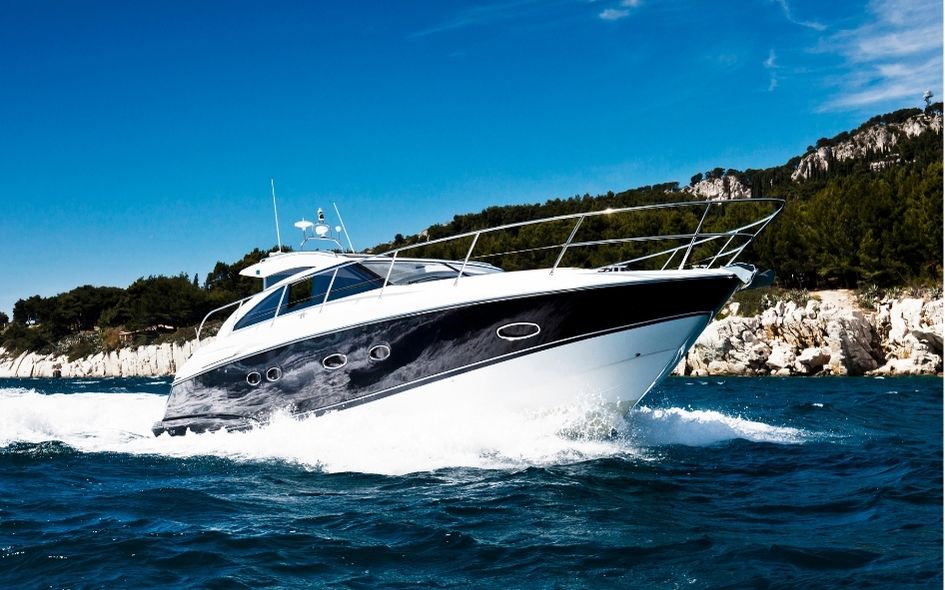It’s very common to refer to a large private vessel as a “yacht” without knowing exactly what its definition is. In this article, we explain the various characteristics that generally qualify a vessel to be categorized as a yacht.
The first thing to keep in mind is that there are no written rules for casual maritime language. Therefore, if someone casually refers to a large sportfishing yacht as a “boat,” it’s likely that no one will correct them (after all, technically, it is a boat). Similarly, if someone wanted to call a 3.5-meter Boston Whaler Super Sport or a Carolina Skiff a “yacht,” go for it! (We won’t tell anyone).
¿Qué es un yate privado?
The word “yacht”
In fact, it’s very common among friends to jokingly call a small boat a “yacht.” In this sense, it’s common, for example, for someone to board their friend’s aluminum fishing boat and say, “Nice yacht!” Of course, if that same friend were to board a real yacht, they would probably be too awestruck to say anything.
This leads to the next question: When does a boat stop being a boat and become a yacht? Is it only a matter of size, or are there other qualities that a boat must have before it can be officially considered a yacht?
What is a private yacht?
This article will answer all of these questions, as well as break down the different classes of yachts, which can be classified in various ways. Regarding the question, “What is the difference between a yacht and a boat?” We all know (or should know) what a boat is, and that there is a wide variety of boats. As we focus on yachts and all that is unique and intriguing about them, the distinction between a yacht and any other boat will become clear.
The origin of yachts
The word “yacht” comes from the Dutch word “jacht,” which means “hunter.” The first yachts were exactly that: pirate hunters. The Dutch navy built fast sailing ships that could navigate the shallow waters of the country to hunt pirates in the 16th century. Quickly, the wealthy in Europe, particularly the English, realized the features and advantages of these ships and began to replicate and compete with them. Therefore, from the beginning, the yacht has been a specialized private boat, relatively expensive, intended for recreational use.
What is a private yacht?
By the late 19th century, several important developments had taken place. Comparison and yacht racing meant that standards had to be established. The British classified yachts by tonnage. Americans used a classification based on length overall, which prevails to this day. Although they began as sailing ships (and there are still sailing yachts), steam power supplanted wind as the main method of propulsion in the 19th century. By 1900, gasoline and diesel engines were the preferred propulsion, as they still are in many boats.
What is a private yacht?
Size matters
If someone points out a large private boat and asks, “Is that a yacht?” the appropriate response is probably, “How big is it?” The maritime definition of a yacht is a privately-owned recreational vessel of at least 10 meters in length overall. At YachtWorld, we tend to consider any vessel from about 11-12 meters in length overall (or larger) as a “yacht.” On the other hand, different types of boats approach being as large, even some motorboats and RIBs. However, a personal watercraft under 9 meters in length overall is typically not considered a yacht. Another point to consider is that if a vessel cannot be towed by a car or truck on a public roadway without special permission (i.e., if it is over 3 meters in beam and likely over 10 feet long) it is likely to be considered a yacht.
What is a private yacht?
This delineation is just where our basic yacht begins as an “entry-level” to be considered as such, as there are other levels of yachts that are even more impressive. On one hand, yachts 24 meters in length overall or more are classified as “large yachts.” On the other hand, beyond 40 meters in length overall, the vessel becomes a “megayacht,” sometimes written as one word, “megayacht.” In this sense, the largest yacht in the world currently is the megayacht Azzam, which measures 180 meters in length overall. The yacht REV with its 183 meters in length overall will surpass the Azzam when completed, as it is currently under construction (these types of vessels typically require over five years to complete).
Classification
Yachts can also be classified according to the water and wind conditions they can withstand:
Class A yachts are those that can withstand winds of up to 70-80 kilometers per hour and waves of approximately 4 meters in open sea. These types of offshore yachts are built to be self-sufficient in hostile seas while sailing in open sea with winds exceeding force 8 on the Beaufort scale and include sportfishing yachts, motor yachts, large cruisers, superyachts, and megayachts.
Class B yachts are often called “coastal vessels” and are built to sail in coastal waters within 320 kilometers of the coast.
Class C vessels are ships built to sail along the coast and near it, including waterways such as lakes, rivers, and bays. Generally, they can sail with waves between 1 meter and 1.5 meters before getting into trouble.
Class D vessels are boats that can safely navigate with winds of 13-15 MPH and waves of half a meter or less in protected waterways. Note: any vessel of a lower class than class B is called a boat, hence the difference.
What is a private yacht?
Operating waters and onboard accommodations
Yachts, from their inception, have been built to withstand long journeys in open waters. Therefore, the most likely place to see a yacht is in deep waters such as the Atlantic or Pacific oceans. According to conventional maritime wisdom, vessels under 9 meters are generally considered inadequate for sailing in rough waters and for prolonged journeys on open sea, due to the length of swells in open sea (although there are some exceptions, and opinions may vary). Thus, by definition, yachts are capable of making extended cruises in more demanding water conditions in open sea. To facilitate this, yachts tend to have on board a greater and more advanced array of deep-water instruments and equipment than smaller recreational vessels.
What is a private yacht?
One obvious distinction in this regard has to do with a yacht’s ability to provide shelter and accommodation to passengers during adverse weather and sea conditions. Most cabin cruisers and pleasure boats have cabins (often called “cuddies”), with narrow berths. Most yachts have bedrooms on another level, like those in a house, not to mention full-sized bathrooms.
Another distinction between vessels and yachts is that the latter must be crewed by professionals (although, again, this is not a hard rule, as many modern yachts can be safely and comfortably operated by one or two individuals). Commercial ships and vessels obviously have professional sailors. Yachts, being recreational vessels, need to employ individuals who have skills that often go beyond those of the private boat owners. Typically, the number of crew members will be twice the number of potential guests on a yacht.
What is a private yacht?
Big wheels
Large yachts and superyachts tend not to be as fast as many smaller vessels, although some are surprisingly fast. A typical cruising speed might be around 12 knots (14 miles per hour). Nevertheless, there are always exceptions such as the superyacht Azzam, which can travel at 30 knots (35 miles per hour). The relatively slow cruising speed of superyachts, however, does not mean that they have small engines. Large yachts have surprisingly large and highly sophisticated power facilities. A typical medium-sized yacht might have two 260-horsepower diesel turbines giving it the ability to travel at up to 20 miles per hour.
¿Qué es un yate privado?
¿Dónde rentar yates para pesca en Los Cabos?
Recuerda que cuentas con nosotros, Cabo VIP, para ayudarte en tu búsqueda y renta de yate para tu participación en torneos de pesca deportiva y esparcimiento. Contestaremos todas tus preguntas, ponte en contacto con nosotros o escribe a nuestro WhatsApp: (+52) 624 218 2300.
¿Necesitas Renta de Yates en Los Cabos? ¿Renta de Yates en La Paz, Cabo San Lucas, San José del Cabo, Loreto, Todos Santos, El Centenario, El Pescadero, Chametla, Melitón Albáñez Domínguez, La Ribera, Los Barriles, El Sargento, Miraflores, General Juan Domínguez Cota, en Baja California Sur, México? ¡Reserva tu yate ahora con Cabo VIP! ¡Descubre nuevos destinos y vive experiencias extraordinarias!
¿Qué es un yate privado?

